Evaporation Heat Transfer and Pressure Drop of Low-Global Warming Potential Refrigerant HFO-1234yf in 6.95-mm Horizontal Smooth Tube
Abstract
:1. Introduction
2. Experimental Apparatus and Conditions
2.1. Experimental Apparatus
2.2. Experimental Conditions
3. Data Reduction
3.1. Heat Transfer Coefficient
3.2. Pressure Drop
3.3. Uncertainty Analysis
4. Result and Discussion
4.1. Heat Transfer Coefficient
4.1.1. Influence of Mass Flux
4.1.2. Influence of Heat Flux
4.1.3. Influence of Saturation Temperature
4.1.4. Comparison of the Heat Transfer Coefficient of R-134a and R-1234yf
4.1.5. Heat Transfer Coefficient of Top and Bottom Side
4.1.6. Flow Pattern Map
4.1.7. Comparison of the Correlations
4.2. Pressure Drop
4.2.1. Influence of Mass Flux
4.2.2. Influence of Saturation Temperature
4.2.3. Comparison of the Pressure Drop of R-134a and R-1234yf
4.2.4. Comparison of the Correlations
5. Conclusions
Author Contributions
Funding
Institutional Review Board Statement
Informed Consent Statement
Acknowledgments
Conflicts of Interest
References
- Illán-Gómez, F.; López-Belchí, A.; García-Cascales, J.R.; Vera-García, F. Experimental two-phase heat transfer coefficient and frictional pressure drop inside mini-channels during condensation with R1234yf and R134a. Int. J. Refrig. 2015, 51, 12–23. [Google Scholar] [CrossRef]
- Padilla, M.; Revellin, R.; Haberschill, P.; Bensafi, A.; Bonjour, J. Flow regimes and two-phase pressure gradient in horizontal straight tubes: Experimental results for HFO-1234yf, R-134a and R-410A. Exp. Therm. Fluid Sci. 2011, 35, 1113–1126. [Google Scholar] [CrossRef]
- Saitoh, S.; Dang, C.; Nakamura, Y.; Hihara, E. Boiling heat transfer of HFO-1234yf flowing in a smooth small-diameter horizontal tube. Int. J. Refrig. 2011, 34, 1846–1853. [Google Scholar] [CrossRef]
- Mortada, S.; Zoughaib, A.; Arzano-Daurelle, C.; Clodic, D. Boiling heat transfer and pressure drop of R-134a and R-1234yf in minni channels for low mass fluxes. Int. J. Refrig. 2012, 35, 962–973. [Google Scholar] [CrossRef]
- Lu, M.C.; Tong, J.R.; Wang, C.C. Investigation of the two-phase convective boiling of HFO-1234yf in a 3.9 mm diameter tube. Int. J. Heat Mass Transf. 2013, 65, 545–551. [Google Scholar] [CrossRef]
- Diani, A.; Mancin, S.; Rossetto, L. Flow boiling heat transfer of R1234yf inside a 3.4 mm ID microfin tube. Exp. Therm. Fluid Sci. 2015, 66, 127–136. [Google Scholar] [CrossRef]
- Choi, K.I.; Chien, N.B.; Oh, J.T. Heat Transfer Coefficient during Evaporation of R-1234yf, R-134a, and R-22 in Horizontal Circular Small Tubes. Adv. Mech. Eng. 2015, 2013, 1–8. [Google Scholar] [CrossRef] [Green Version]
- Sempértegui-Tapia, D.F.; Ribatski, G. Flow boiling heat transfer of R134a and low GWP refrigerants in a horizontal micro-scale channel. Int. J. Heat Mass Transf. 2017, 108, 2417–2432. [Google Scholar] [CrossRef]
- Kedzierski, D.K. Horizontal convective boiling of R1234yf, R134a, and R450A within a micro-fin tube. Int. J. Refrig. 2018, 88, 538–551. [Google Scholar] [CrossRef] [PubMed]
- Pabon, J.G.; Khosravi, A.; Nunes, R.; Machado, L. Experimental investigation of pressure drop during two-phase flow of R1234yf in smooth horizontal tubes with internal diameters of 3.2 mm to 8.0 mm. Int. J. Refrig. 2019, 104, 426–436. [Google Scholar] [CrossRef]
- Del Col, D.; Bortolin, S.; Torresin, D.; Cavallini, A. Flow boiling of R1234yf in a 1 mm diameter channel. Int. J. Refrig. 2013, 36, 353–362. [Google Scholar] [CrossRef]
- Oh, J.T.; Choi, K.I.; Nguyen, C.B.; Kim, K.W. Boiling Heat Transfer of R-1234yf in Horizontal Circular Small Tubes. Int. Refrig. Air Cond. Conf. 2012, 34, 1–7. [Google Scholar]
- Kim, K.W.; Chien, N.B.; Choi, K.I.; Oh, J.T. Measurement and correlation of boiling heat transfer coefficient of R-1234yf in horizontal small tubes. J. Mech. Sci. Technol. 2014, 28, 4301–4308. [Google Scholar] [CrossRef]
- Anwar, Z.; Palm, B.; Khodabandeh, R. Flow boiling heat transfer, pressure drop and dryout characteristics of R1234yf: Experimental results and predictions. Exp. Therm. Fluid Sci. 2015, 66, 137–149. [Google Scholar] [CrossRef]
- Yang, C.Y.; Nalbandian, H.; Lin, F.C. Flow boiling heat transfer and pressure drop of refrigerants HFO-1234yf and HFC-134a in small circular tube. Int. J. Heat Mass Transf. 2018, 121, 726–735. [Google Scholar] [CrossRef]
- Choi, K.I.; Oh, J.T.; Saito, K.; Jeong, J.S. Comparison of heat transfer coefficient during evaporation of natural refrigerants and R-1234yf in horizontal small tube. Int. J. Refrig. 2014, 41, 210–218. [Google Scholar] [CrossRef]
- Jige, D.; Kikuchi, S.; Mikajiri, N.; Inoue, N. Flow boiling heat transfer of zeotropic mixture R1234yf/R32 inside a horizontal multiport tube. Int. J. Refrig. 2020, 119, 390–400. [Google Scholar] [CrossRef]
- Sajadi, B.; Najafizadeh, M.M.; Soleimani, M.; Behabadi, M.A.; Naserinejad, J. The effect of wire-coil inserts on the heat transfer and pressure drop of R1234yf flow boiling. Appl. Therm. Eng. 2019, 152, 615–623. [Google Scholar] [CrossRef]
- Zhang, J.; Desideri, A.; Kærn, M.R.; Ommen, T.S.; Wronski, J.; Haglind, F. Flow boiling heat transfer and pressure drop characteristics of R134a, R1234yf and R1234ze in a plate heat exchanger for organic Rankine cycle units. Int. J. Heat Mass Transf. 2017, 108, 1787–1801. [Google Scholar] [CrossRef] [Green Version]
- NIST, REFPROP 8.0. Available online: https://www.techstreet.com/standards/nist-refprop-8-0?product_id=1696006 (accessed on 3 October 2021).
- Roetzel, W.; Luo, X.; Chen, D. Design and Operation of Heat Exchangers and Their Networks; Convey, M., Adamson, P., Eds.; Academic Press: Cambridge, MA, USA, 2020; pp. 13–69. [Google Scholar]
- Rouhani, Z.; Axelsson, E. Calculation of void volume fraction in the subcooled and quality boiling regions. Int. J. Heat Mass Transf. 1970, 13, 383–393. [Google Scholar] [CrossRef]
- Kline, J.S.; McClintock, F.A. Describing Uncertainties in Single-Sample Experiments. Mech. Eng. 1953, 75, 3–8. [Google Scholar]
- Taitel, Y.L.; Dukler, A.E. A model for predicting flow regime transitions in horizontal and near horizontal gas-liquid flow. AIChE J. 1976, 22, 47–55. [Google Scholar] [CrossRef]
- Gungor, K.E.; Winterton, R.H.S. A general correlation for saturated flow boiling and comparisons of correlations with data. Chem. Eng. Res. Des. 1987, 65, 148–156. [Google Scholar]
- Kandlikar, S.G. A Gerneral Correlation for Saturated Two-Phase Flow Boiling Heat Transfer Inside Horizontal and Vertical Tubes. J. Heat Transf. 1990, 112, 219–228. [Google Scholar] [CrossRef] [Green Version]
- Liu, Z.; Winterton, R.H.S. A general correlation for saturated and subcooled flow boiling in tubes and annuli, based on a nucleate pool boiling equation. Int. J. Heat Mass Transf. 1991, 34, 2759–2766. [Google Scholar] [CrossRef]
- Mohammed, S.M. Chart correlation for saturated boiling heat transfer: Equations and further study. ASHRAE Trans. 1982, 88, 185–196. [Google Scholar]
- Lockhart, R.W.; Martinelli, R.C. Proposed correlation of data for isothermal two-phase, two-component flow in pipes. Chem. Eng. Prog. 1949, 45, 39–48. [Google Scholar]
- Friedel, L. Improved friction pressure drop correlation for horizontal and vertical two-phase pipe flow. Mater. Sci. 1979, 18, 485–491. [Google Scholar]
- Müller-Steinhagen, H.; Heck, K. A simple friction pressure drop correlation for two-phase flow in pipes. Chem. Eng. Process. 1986, 20, 297–308. [Google Scholar] [CrossRef]
- Moreno Quibén, J.; Thome, J.R. Flow pattern based two-phase frictional pressure drop model for horizontal tubes, Part II: New phenomenological model. Int. J. Heat Fluid Flow 2007, 28, 1060–1072. [Google Scholar] [CrossRef]
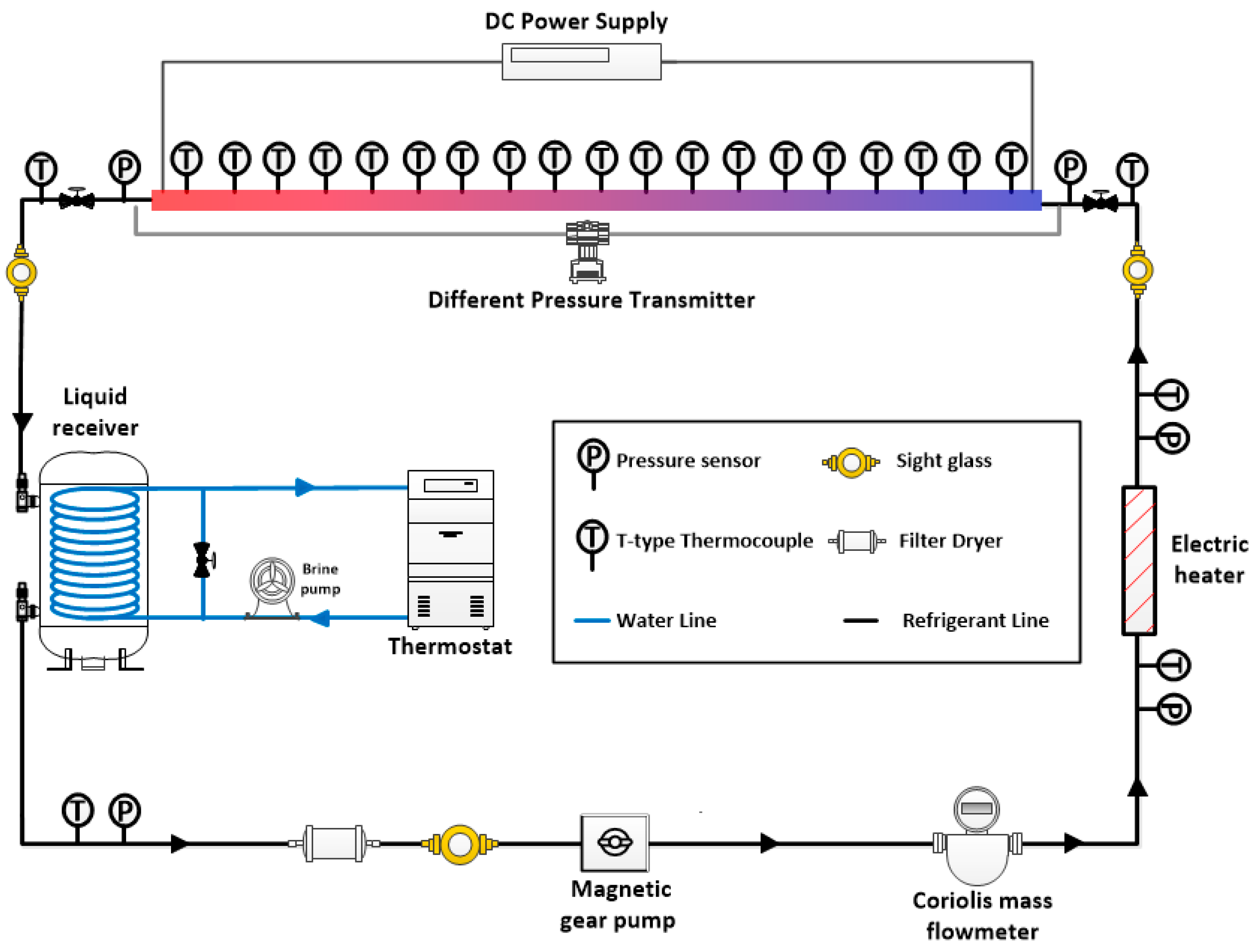

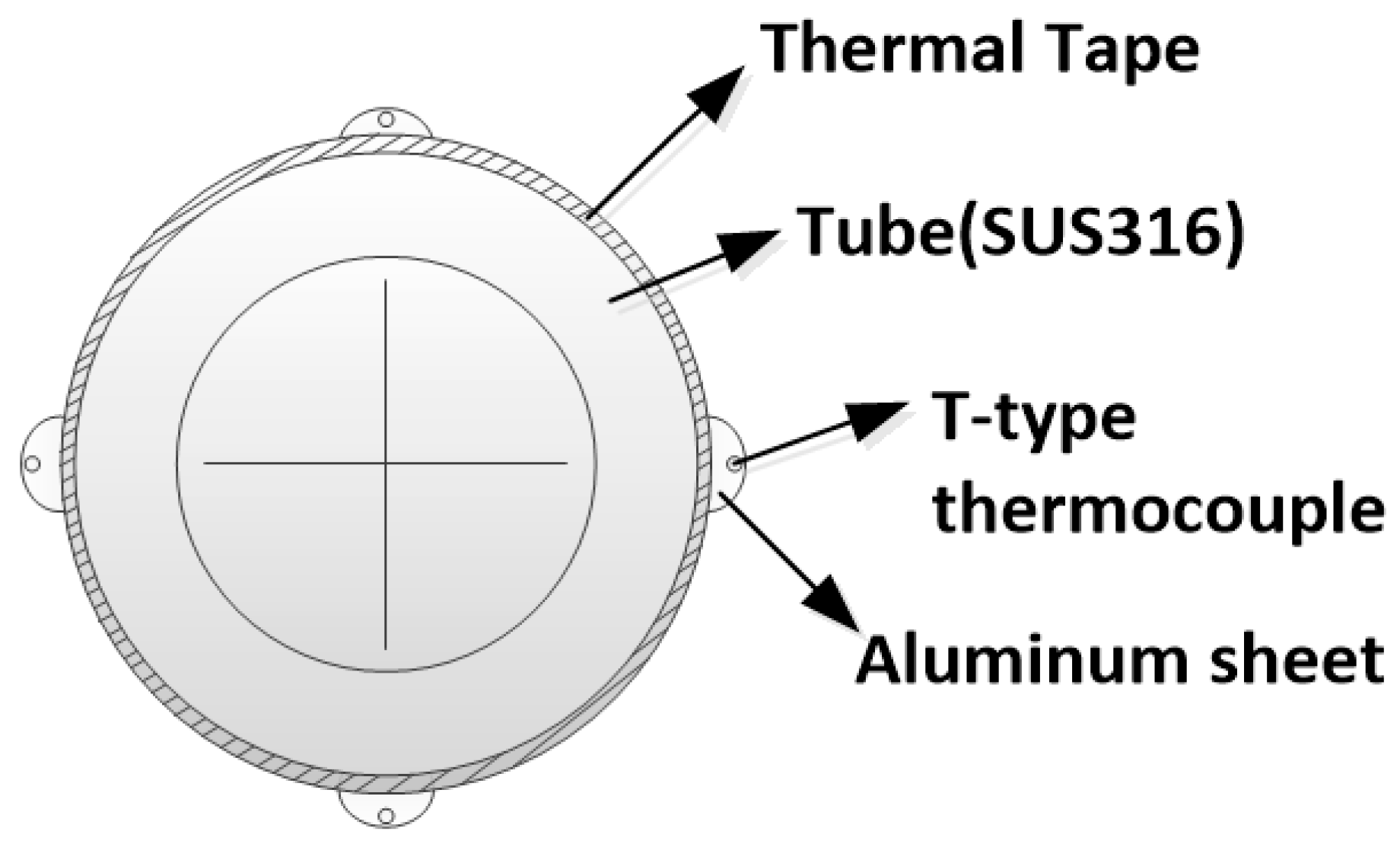
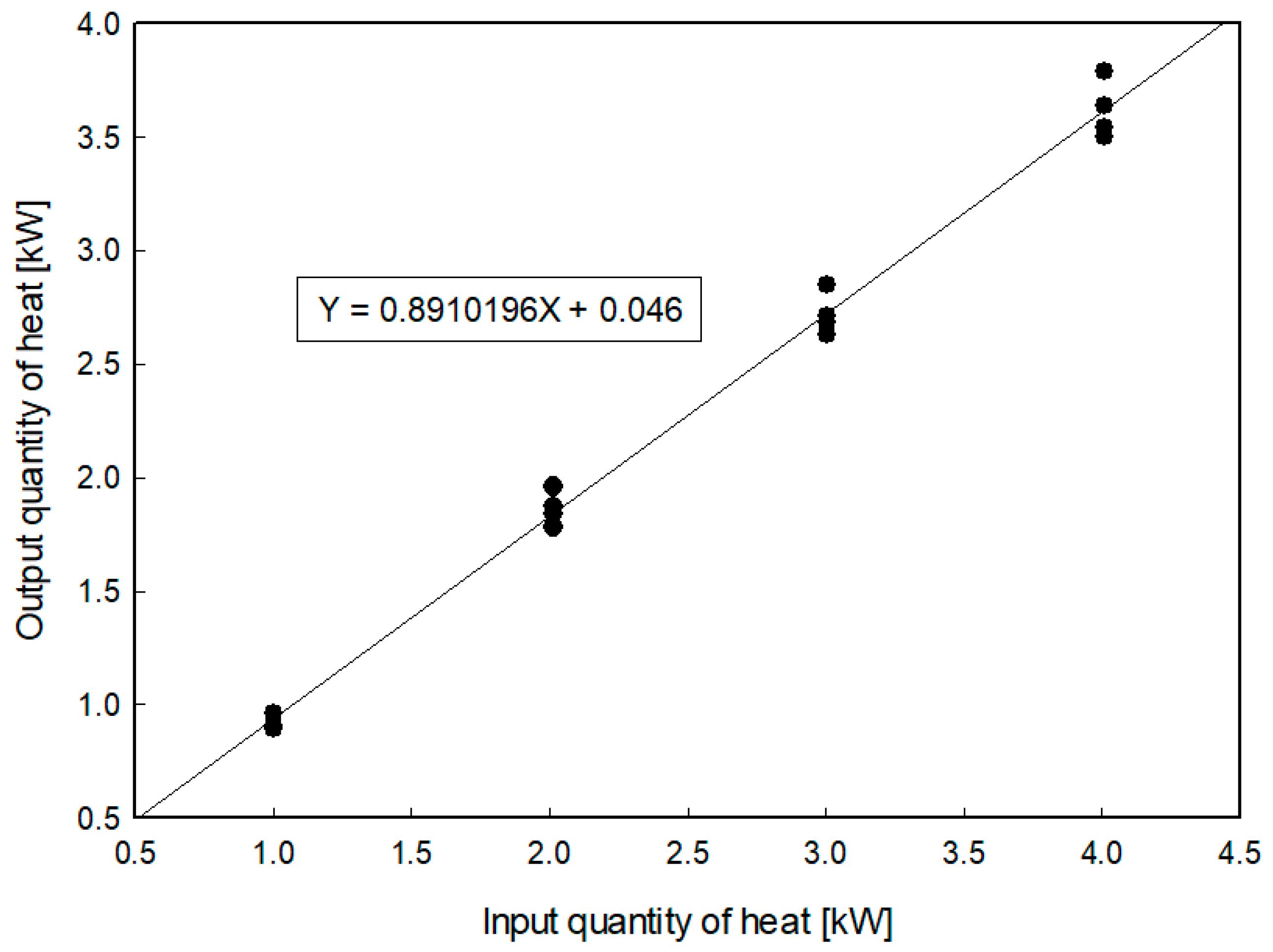
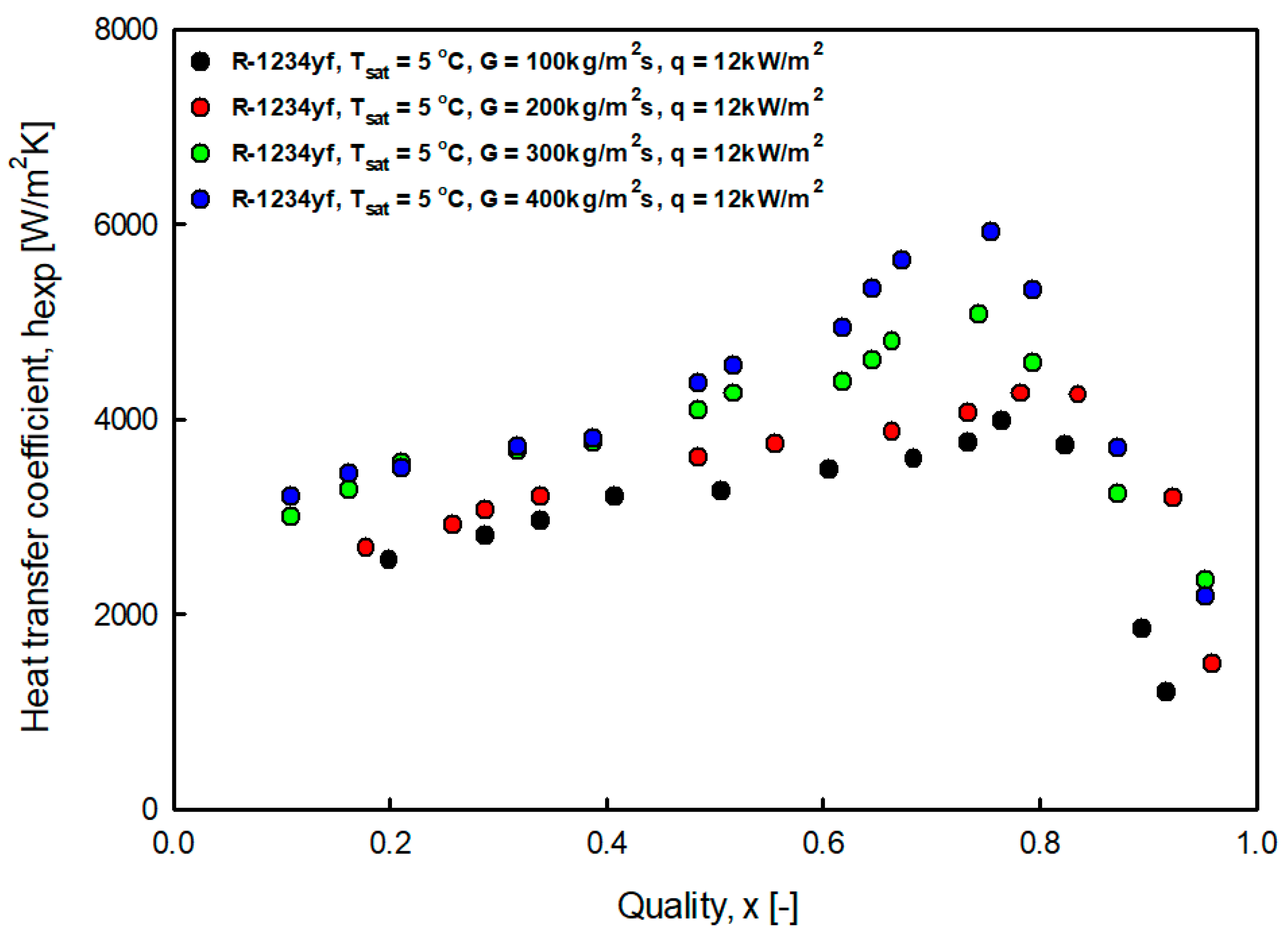

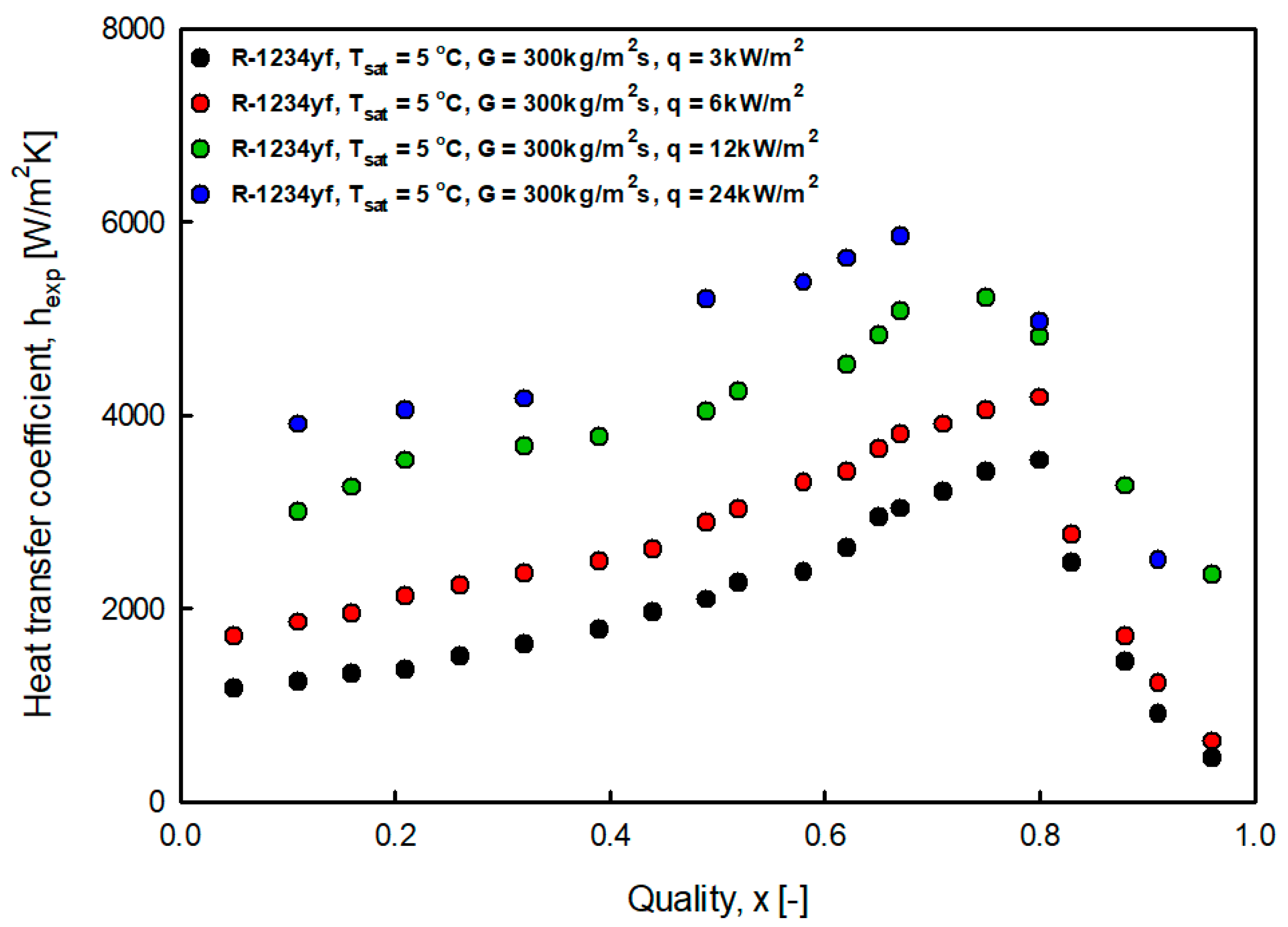


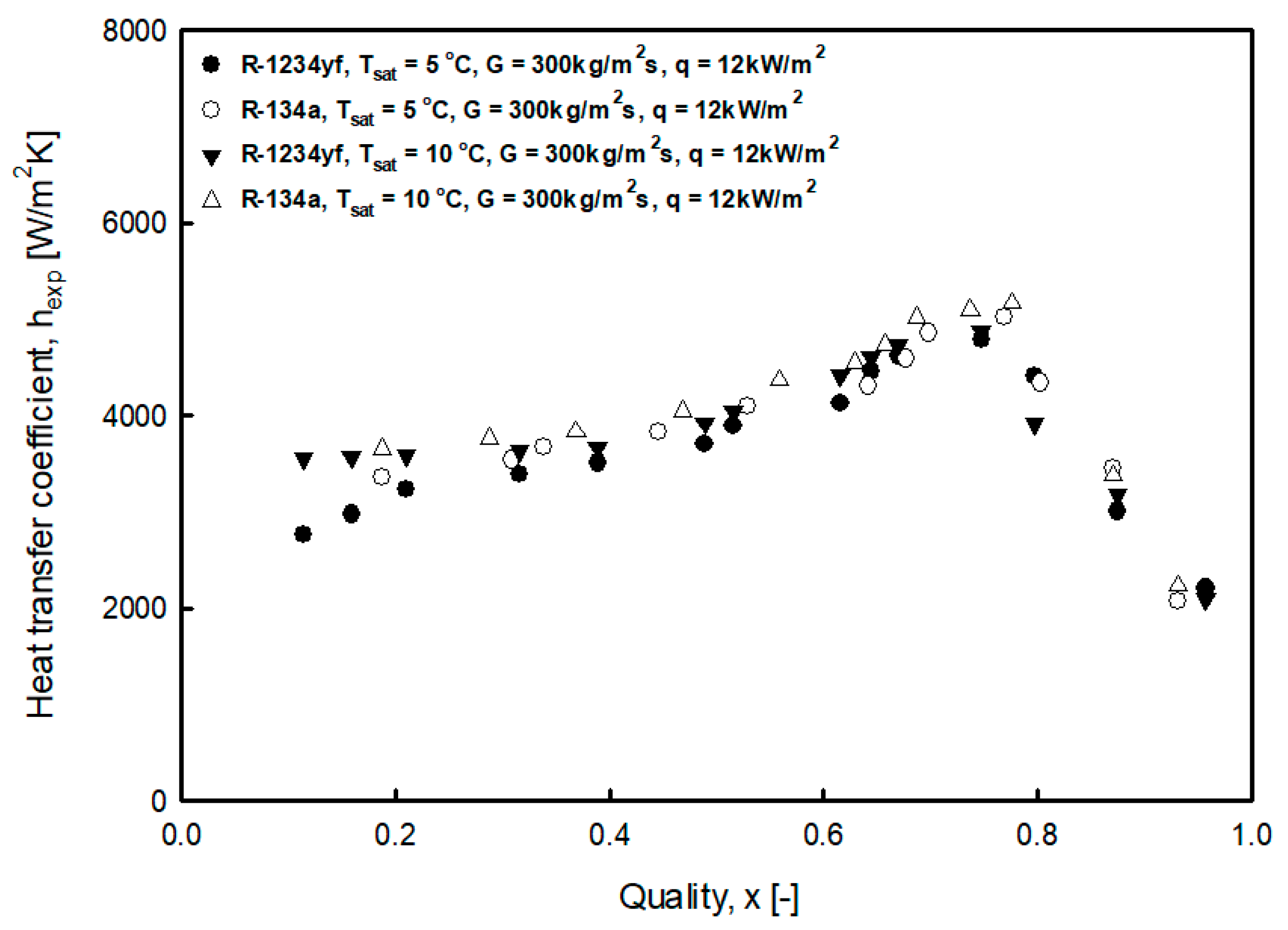
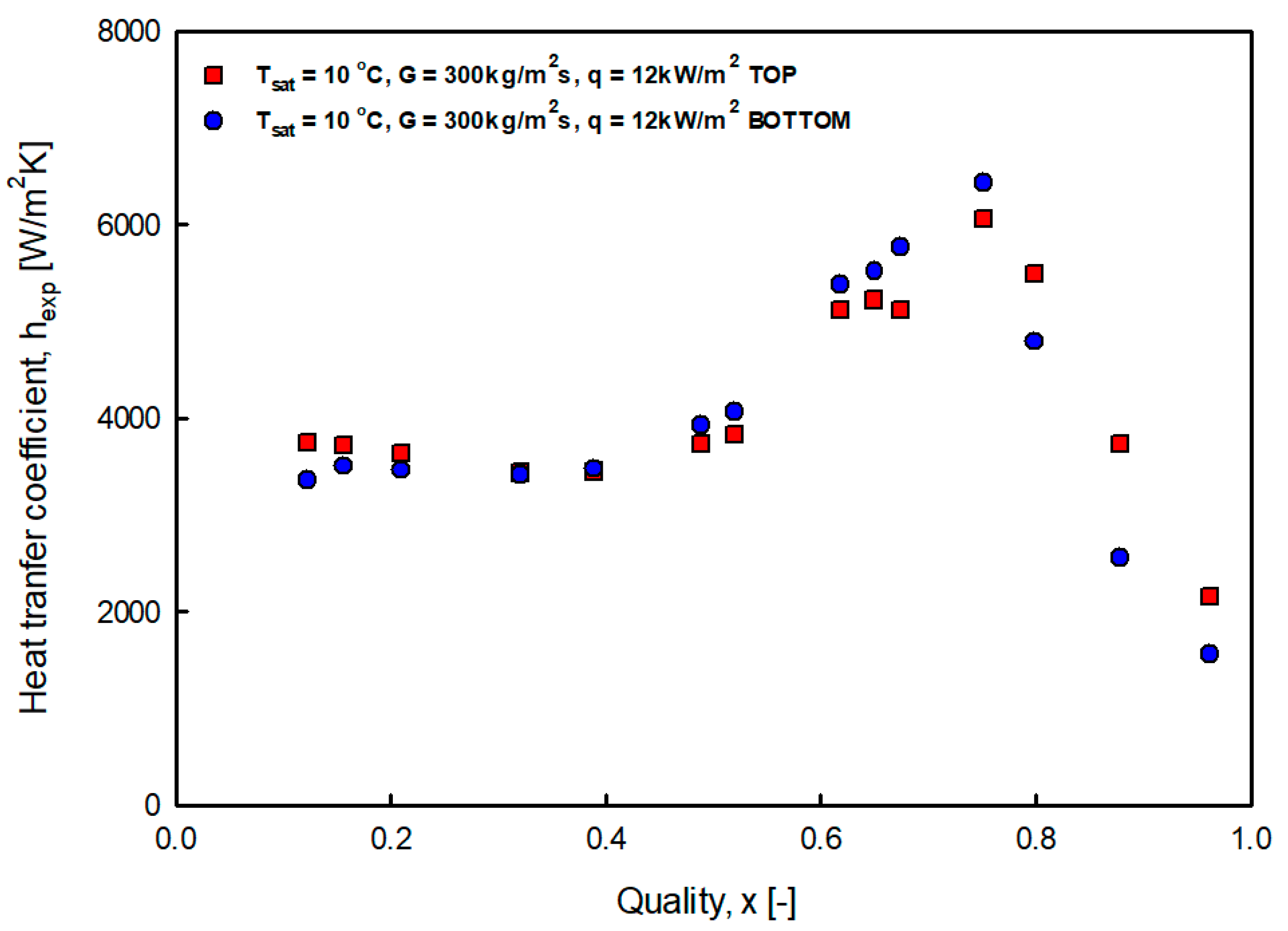
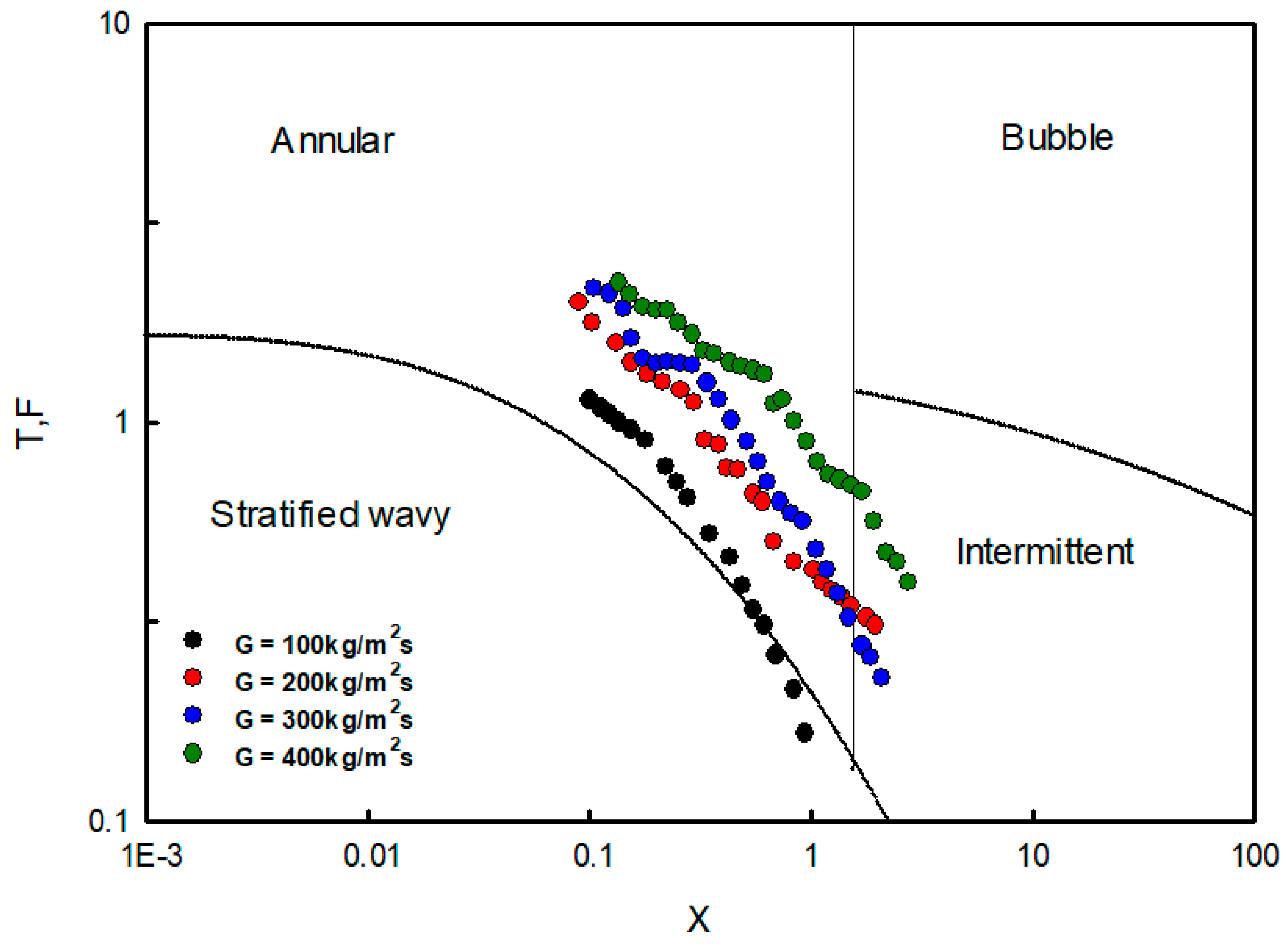

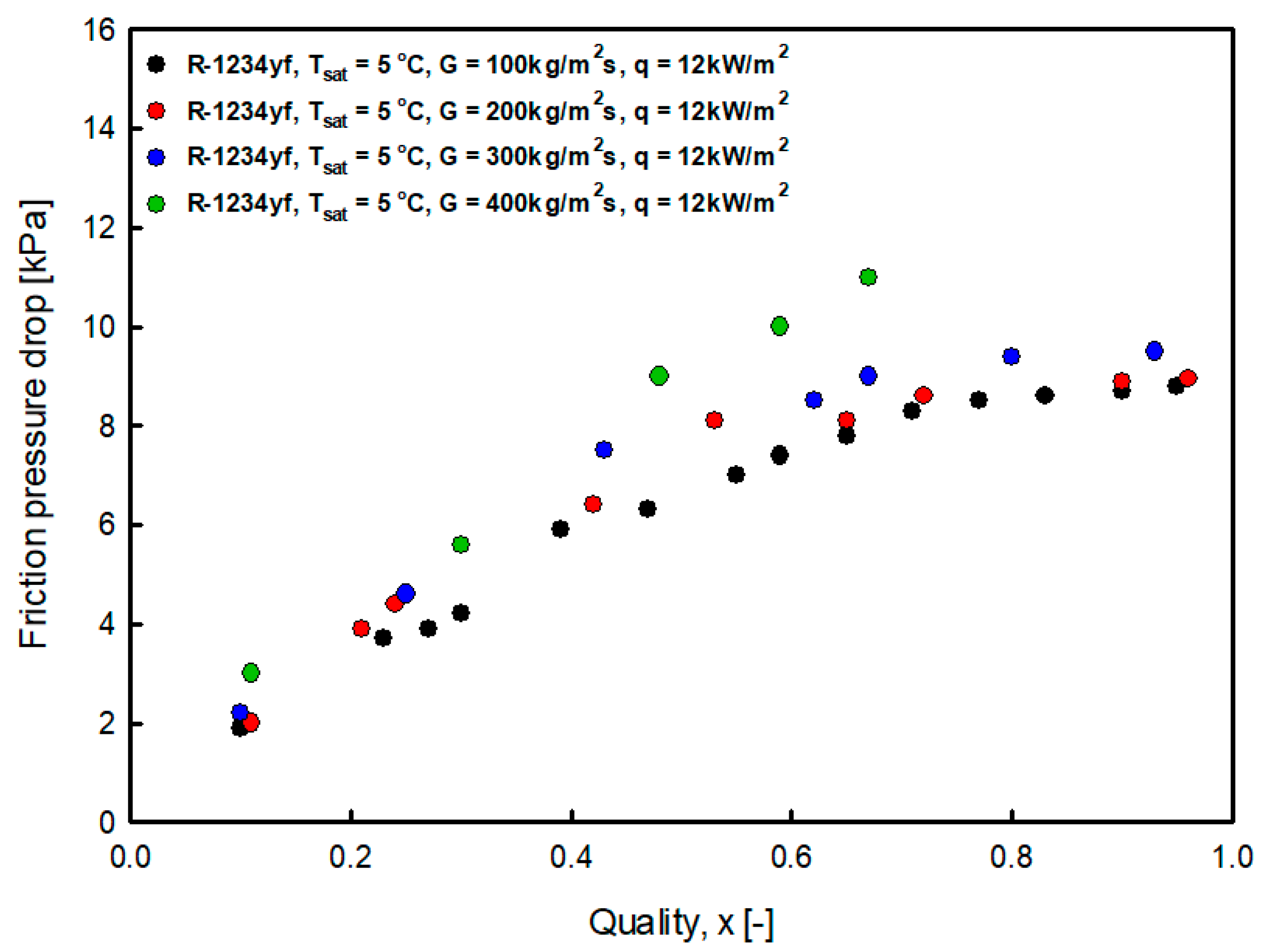
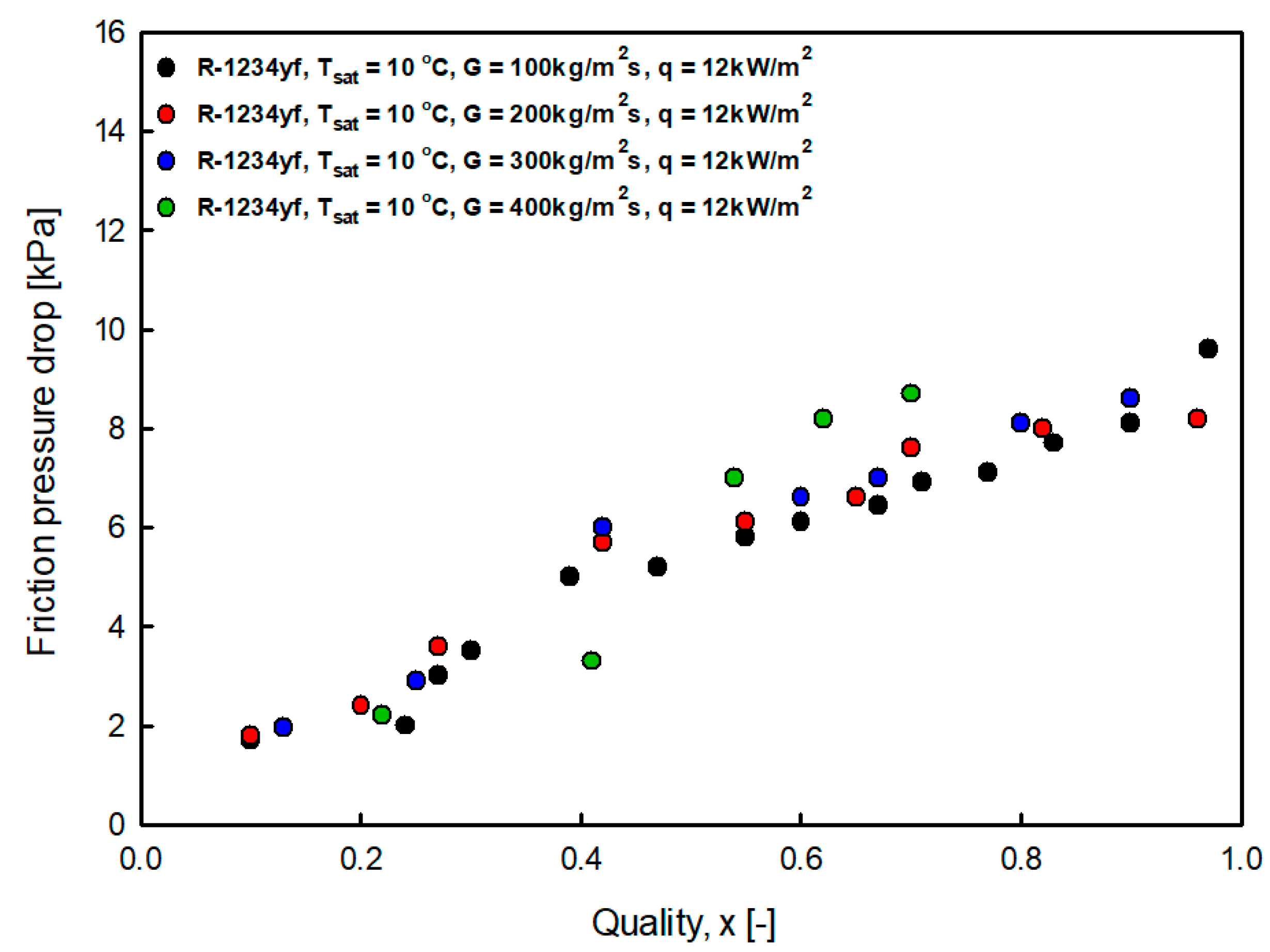
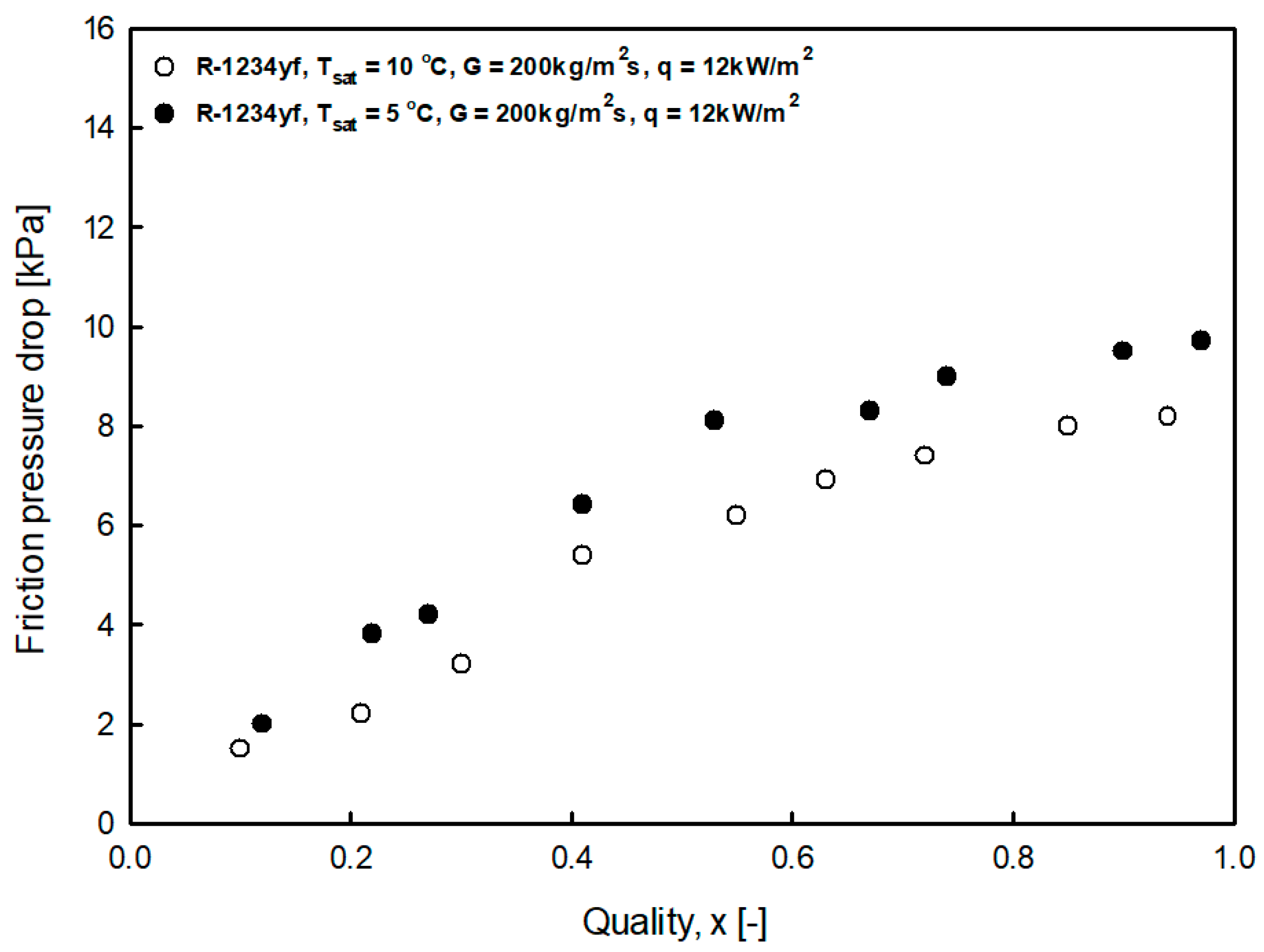
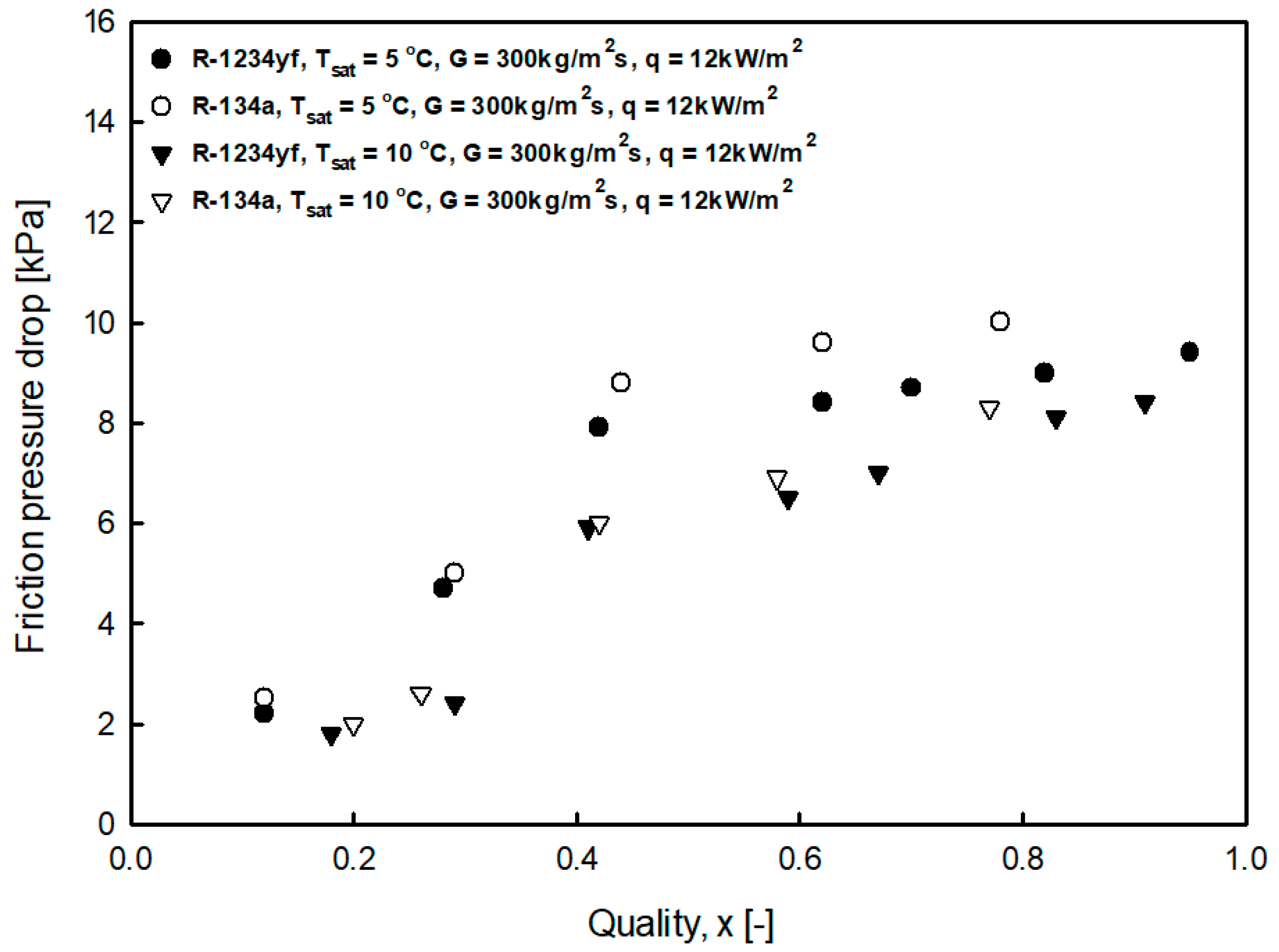
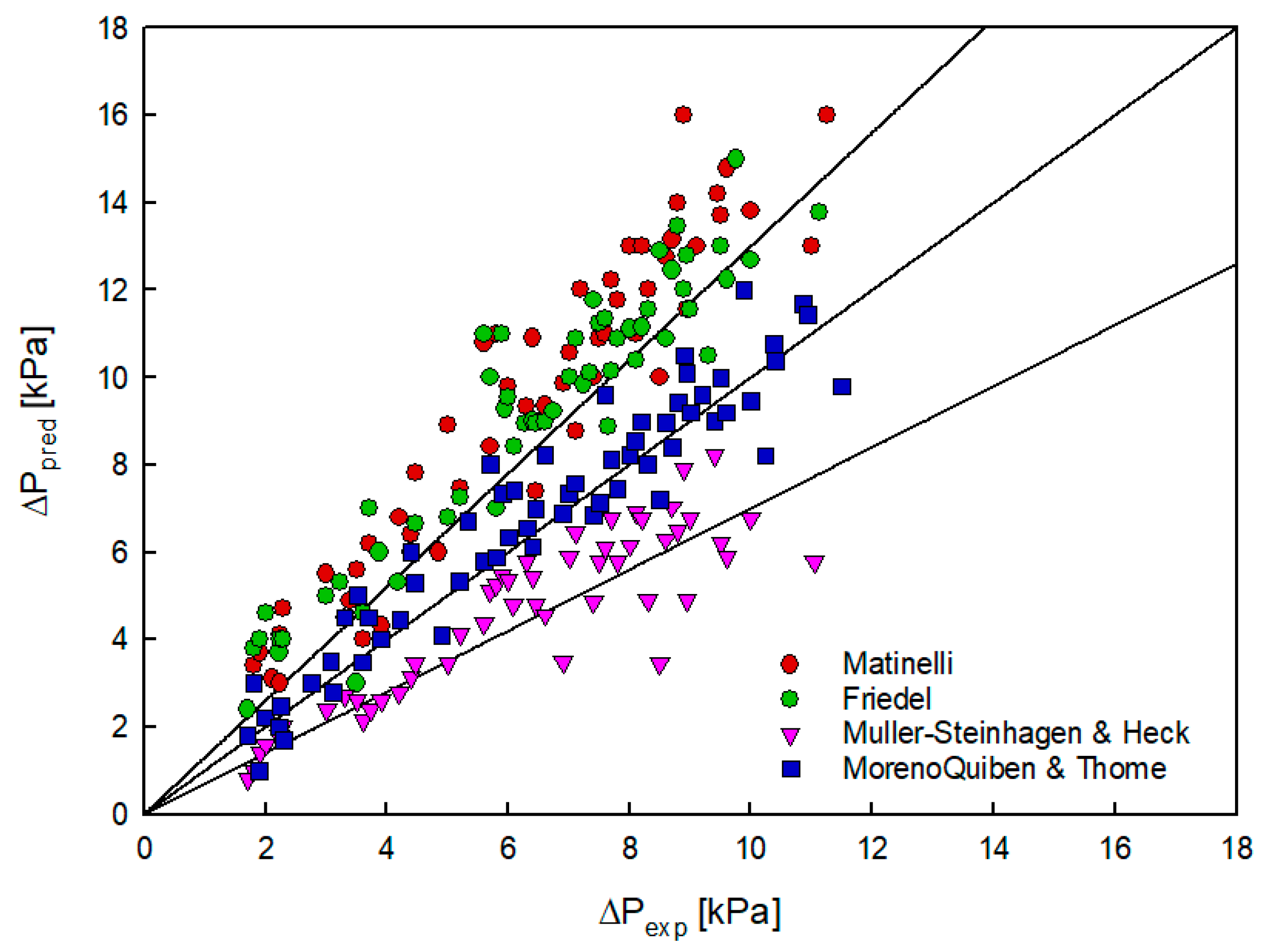
| Author | Tube Type | di (mm) | Refrigerant | G (kg/m2s) | Tsat (°C) | x (-) |
|---|---|---|---|---|---|---|
| Illán-Gómez et al. [1] | mini channel | 1.16 | R-134a R-1234yf | 350–940 | 30–55 | 0.1–0.89 |
| Padilla et al. [2] | Straight tube | 7.90, 10.85 | R134a R1234yf | 187–1702 | 4.8–20.7 | 0.04–0.98 |
| Saitoh et al. [3] | Smooth tube | 2.0 | R1234yf | 100–400 | 15 | 0–0.25 |
| Mortada et al. [4] | Rectangular minichannel | 1.1 | R134a R1234yf | 20–100 | - | 0–1.0 |
| Lu et al. [5] | Smooth tube | 3.9 | R134a, R1234yf | 100–500 | 10 | 0.1–0.9 |
| Diani et al. [6] | Mini microfin tube | 3.4 | R134a R1234yf | 190–940 | 30 | 0.1–0.99 |
| Choi et al. [7] | Horizontal tube | 1.5, 3.0 | R134a R1234yf | 100–650 | 5, 10 | 0–1.0 |
| Sempértegui-Tapia et al. [8] | micro channel | 1.1 | R-134a R-1234yf | 200–800 | 31–41 | 0.05–0.95 |
| Kedzierski et al. [9] | microfin tube | 8.8 | R134a R1234yf | 96–318 | 0–8.8 | 0.03–0.87 |
| Pabon et al. [10] | Smooth tube | 3.2, 4.8, 6.4, 8.0 | R134a R1234yf | 200–400 | 20, 30 | 0–1.0 |
| Del Col et al. [11] | Micro minichannel | 1.0 | R134a R1234yf | 200–600 | 31 | 0.05–0.9 |
| Oh et al. [12] | Horizontal tube | 1.5, 3.0 | R1234yf | 50–600 | 0, 5, 10 | 0–1.0 |
| Kim et al. [13] | Horizontal tube | 1.5, 3.0 | R1234yf | 200–650 | 15 | 0–1.0 |
| Anwar et al. [14] | Vertical minichannel | 1.6 | R134a R1234yf | 100–500 | 27, 32 | 0–1.0 |
| Yang et al. [15] | Smooth tube | 4.0 | R134a R1234yf | 200–1200 | 14 | 0.191–0.249 |
| Parameter | Unit | Value |
|---|---|---|
| Refrigerant | - | R-1234yf |
| Quality | - | 0~1 |
| Saturation temperature | °C | 5, 10 |
| Mass flux | kg/m2s | 100~00 |
| Heat flux | kW/m2 | 6~24 |
| Tube length | mm | 3000 |
| Tube diameter | mm | 6.95 |
| Flow Meter | Uncertainty: ±0.1% | Flow Meter |
|---|---|---|
| T-type thermocouple | Uncertainty: ±0.75% | T-type thermocouple |
| Pressure transmitter | Uncertainty: ±0.25% | Pressure transmitter |
| Differential pressure transmitter | Uncertainty: ±0.25% | Differential pressure transmitter |
| Property | Unit | Tsat = 5 °C | Tsat = 10 °C | ||
|---|---|---|---|---|---|
| R-134a | R-1234yf | R-134a | R-1234yf | ||
| Saturation pressure | kPa | 349.66 | 372.92 | 414.61 | 437.53 |
| Liquid density | kg/m3 | 1278.1 | 1160.4 | 1261.0 | 1144.0 |
| Vapor density | kg/m3 | 17.131 | 20.744 | 20.226 | 24.267 |
| Liquid thermal conductivity | W/mK | 89.806 | 73.422 | 87.618 | 71.978 |
| Vapor thermal conductivity | W/mK | 11.954 | 12.044 | 12.402 | 12.471 |
| Liquid specific heat | J/kgK | 1.3552 | 1.3080 | 1.3704 | 1.3274 |
| Vapor specific heat | J/kgK | 0.9206 | 0.94835 | 0.9455 | 0.9717 |
| Liquid viscosity | 10−6 N/m2s | 250.11 | 197.10 | 234.87 | 185.64 |
| Vapor viscosity | 10−6 N/m2s | 10.911 | 11.363 | 11.099 | 11.581 |
| Surface tension | 10−6 N/m | 10.844 | 8.6919 | 10.138 | 8.0364 |
Publisher’s Note: MDPI stays neutral with regard to jurisdictional claims in published maps and institutional affiliations. |
© 2021 by the authors. Licensee MDPI, Basel, Switzerland. This article is an open access article distributed under the terms and conditions of the Creative Commons Attribution (CC BY) license (https://creativecommons.org/licenses/by/4.0/).
Share and Cite
Son, C.-H.; Kim, N.-W.; Yoon, J.-I.; Seol, S.-H.; Lee, J.-H. Evaporation Heat Transfer and Pressure Drop of Low-Global Warming Potential Refrigerant HFO-1234yf in 6.95-mm Horizontal Smooth Tube. Energies 2021, 14, 6325. https://doi.org/10.3390/en14196325
Son C-H, Kim N-W, Yoon J-I, Seol S-H, Lee J-H. Evaporation Heat Transfer and Pressure Drop of Low-Global Warming Potential Refrigerant HFO-1234yf in 6.95-mm Horizontal Smooth Tube. Energies. 2021; 14(19):6325. https://doi.org/10.3390/en14196325
Chicago/Turabian StyleSon, Chang-Hyo, Nam-Wook Kim, Jung-In Yoon, Sung-Hoon Seol, and Joon-Hyuk Lee. 2021. "Evaporation Heat Transfer and Pressure Drop of Low-Global Warming Potential Refrigerant HFO-1234yf in 6.95-mm Horizontal Smooth Tube" Energies 14, no. 19: 6325. https://doi.org/10.3390/en14196325






